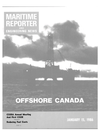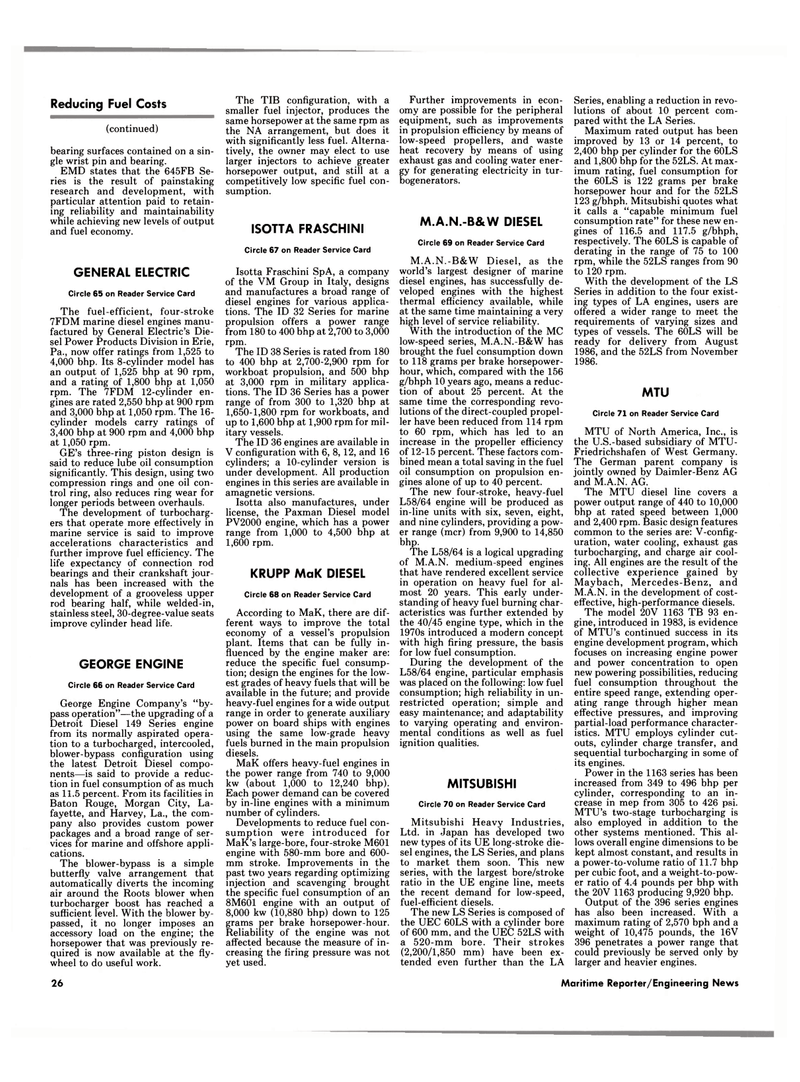
Page 24: of Maritime Reporter Magazine (January 15, 1986)
Read this page in Pdf, Flash or Html5 edition of January 15, 1986 Maritime Reporter Magazine
Reducing Fuel Costs (continued) bearing surfaces contained on a sin- gle wrist pin and bearing.
EMD states that the 645FB Se- ries is the result of painstaking research and development, with particular attention paid to retain- ing reliability and maintainability while achieving new levels of output and fuel economy.
GENERAL ELECTRIC
Circle 65 on Reader Service Card
The fuel-efficient, four-stroke 7FDM marine diesel engines manu- factured by General Electric's Die- sel Power Products Division in Erie,
Pa., now offer ratings from 1,525 to 4,000 bhp. Its 8-cylinder model has an output of 1,525 bhp at 90 rpm, and a rating of 1,800 bhp at 1,050 rpm. The 7FDM 12-cylinder en- gines are rated 2,550 bhp at 900 rpm and 3,000 bhp at 1,050 rpm. The 16- cylinder models carry ratings of 3,400 bhp at 900 rpm and 4,000 bhp at 1,050 rpm.
GE's three-ring piston design is said to reduce lube oil consumption significantly. This design, using two compression rings and one oil con- trol ring, also reduces ring wear for longer periods between overhauls.
The development of turbocharg- ers that operate more effectively in marine service is said to improve accelerations characteristics and further improve fuel efficiency. The life expectancy of connection rod bearings and their crankshaft jour- nals has been increased with the development of a grooveless upper rod bearing half, while welded-in, stainless steel, 30-degree-value seats improve cylinder head life.
GEORGE ENGINE
Circle 66 on Reader Service Card
George Engine Company's "by- pass operation"—the upgrading of a
Detroit Diesel 149 Series engine from its normally aspirated opera- tion to a turbocharged, intercooled, blower-bypass configuration using the latest Detroit Diesel compo- nents—is said to provide a reduc- tion in fuel consumption of as much as 11.5 percent. From its facilities in
Baton Rouge, Morgan City, La- fayette, and Harvey, La., the com- pany also provides custom power packages and a broad range of ser- vices for marine and offshore appli- cations.
The blower-bypass is a simple butterfly valve arrangement that automatically diverts the incoming air around the Roots blower when turbocharger boost has reached a sufficient level. With the blower by- passed, it no longer imposes an accessory load on the engine; the horsepower that was previously re- quired is now available at the fly- wheel to do useful work.
The TIB configuration, with a smaller fuel injector, produces the same horsepower at the same rpm as the NA arrangement, but does it with significantly less fuel. Alterna- tively, the owner may elect to use larger injectors to achieve greater horsepower output, and still at a competitively low specific fuel con- sumption.
ISOTTA FRASCHINI
Circle 67 on Reader Service Card
Isotta Fraschini SpA, a company of the VM Group in Italy, designs and manufactures a broad range of diesel engines for various applica- tions. The ID 32 Series for marine propulsion offers a power range from 180 to 400 bhp at 2,700 to 3,000 rpm.
The ID 38 Series is rated from 180 to 400 bhp at 2,700-2,900 rpm for workboat propulsion, and 500 bhp at 3,000 rpm in military applica- tions. The ID 36 Series has a power range of from 300 to 1,320 bhp at 1,650-1,800 rpm for workboats, and up to 1,600 bhp at 1,900 rpm for mil- itary vessels.
The ID 36 engines are available in
V configuration with 6, 8, 12, and 16 cylinders; a 10-cylinder version is under development. All production engines in this series are available in amagnetic versions.
Isotta also manufactures, under license, the Paxman Diesel model
PV2000 engine, which has a power range from 1,000 to 4,500 bhp at 1,600 rpm.
KRUPP MaK DIESEL
Circle 68 on Reader Service Card
According to MaK, there are dif- ferent ways to improve the total economy of a vessel's propulsion plant. Items that can be fully in- fluenced by the engine maker are: reduce the specific fuel consump- tion; design the engines for the low- est grades of heavy fuels that will be available in the future; and provide heavy-fuel engines for a wide output range in order to generate auxiliary power on board ships with engines using the same low-grade heavy fuels burned in the main propulsion diesels.
MaK offers heavy-fuel engines in the power range from 740 to 9,000 kw (about 1,000 to 12,240 bhp).
Each power demand can be covered by in-line engines with a minimum number of cylinders.
Developments to reduce fuel con- sumption were introduced for
MaK's large-bore, four-stroke M601 engine with 580-mm bore and 600- mm stroke. Improvements in the past two years regarding optimizing injection and scavenging brought the specific fuel consumption of an 8M601 engine with an output of 8,000 kw (10,880 bhp) down to 125 grams per brake horsepower-hour.
Reliability of the engine was not affected because the measure of in- creasing the firing pressure was not yet used.
Further improvements in econ- omy are possible for the peripheral equipment, such as improvements in propulsion efficiency by means of low-speed propellers, and waste heat recovery by means of using exhaust gas and cooling water ener- gy for generating electricity in tur- bogenerators.
M.A.N.-B&W DIESEL
Circle 69 on Reader Service Card
M.A.N.-B&W Diesel, as the world's largest designer of marine diesel engines, has successfully de- veloped engines with the highest thermal efficiency available, while at the same time maintaining a very high level of service reliability.
With the introduction of the MC low-speed series, M.A.N.-B&W has brought the fuel consumption down to 118 grams per brake horsepower- hour, which, compared with the 156 g/bhph 10 years ago, means a reduc- tion of about 25 percent. At the same time the corresponding revo- lutions of the direct-coupled propel- ler have been reduced from 114 rpm to 60 rpm, which has led to an increase in the propeller efficiency of 12-15 percent. These factors com- bined mean a total saving in the fuel oil consumption on propulsion en- gines alone of up to 40 percent.
The new four-stroke, heavy-fuel
L58/64 engine will be produced as in-line units with six, seven, eight, and nine cylinders, providing a pow- er range (mcr) from 9,900 to 14,850 bhp.
The L58/64 is a logical upgrading of M.A.N, medium-speed engines that have rendered excellent service in operation on heavy fuel for al- most 20 years. This early under- standing of heavy fuel burning char- acteristics was further extended by the 40/45 engine type, which in the 1970s introduced a modern concept with high firing pressure, the basis for low fuel consumption.
During the development of the
L58/64 engine, particular emphasis was placed on the following: low fuel consumption; high reliability in un- restricted operation; simple and easy maintenance; and adaptability to varying operating and environ- mental conditions as well as fuel ignition qualities.
MITSUBISHI
Circle 70 on Reader Service Card
Mitsubishi Heavy Industries,
Ltd. in Japan has developed two new types of its UE long-stroke die- sel engines, the LS Series, and plans to market them soon. This new series, with the largest bore/stroke ratio in the UE engine line, meets the recent demand for low-speed, fuel-efficient diesels.
The new LS Series is composed of the UEC 60LS with a cylinder bore of 600 mm, and the UEC 52LS with a 520-mm bore. Their strokes (2,200/1,850 mm) have been ex- tended even further than the LA
Series, enabling a reduction in revo- lutions of about 10 percent com- pared witht the LA Series.
Maximum rated output has been improved by 13 or 14 percent, to 2,400 bhp per cylinder for the 60LS and 1,800 bhp for the 52LS. At max- imum rating, fuel consumption for the 60LS is 122 grams per brake horsepower hour and for the 52LS 123 g/bhph. Mitsubishi quotes what it calls a "capable minimum fuel consumption rate" for these new en- gines of 116.5 and 117.5 g/bhph, respectively. The 60LS is capable of derating in the range of 75 to 100 rpm, while the 52LS ranges from 90 to 120 rpm.
With the development of the LS
Series in addition to the four exist- ing types of LA engines, users are offered a wider range to meet the requirements of varying sizes and types of vessels. The 60LS will be ready for delivery from August 1986, and the 52LS from November 1986.
MTU
Circle 71 on Reader Service Card
MTU of North America, Inc., is the U.S.-based subsidiary of MTU-
Friedrichshafen of West Germany.
The German parent company is jointly owned by Daimler-Benz AG and M.A.N. AG.
The MTU diesel line covers a power output range of 440 to 10,000 bhp at rated speed between 1,000 and 2,400 rpm. Basic design features common to the series are: V-config- uration, water cooling, exhaust gas turbocharging, and charge air cool- ing. All engines are the result of the collective experience gained by
Maybach, Mercedes-Benz, and
M.A.N, in the development of cost- effective, high-performance diesels.
The model 20V 1163 TB 93 en- gine, introduced in 1983, is evidence of MTU's continued success in its engine development program, which focuses on increasing engine power and power concentration to open new powering possibilities, reducing fuel consumption throughout the entire speed range, extending oper- ating range through higher mean effective pressures, and improving partial-load performance character- istics. MTU employs cylinder cut- outs, cylinder charge transfer, and sequential turbocharging in some of its engines.
Power in the 1163 series has been increased from 349 to 496 bhp per cylinder, corresponding to an in- crease in mep from 305 to 426 psi.
MTU's two-stage turbocharging is also employed in addition to the other systems mentioned. This al- lows overall engine dimensions to be kept almost constant, and results in a power-to-volume ratio of 11.7 bhp per cubic foot, and a weight-to-pow- er ratio of 4.4 pounds per bhp with the 20V 1163 producing 9,920 bhp.
Output of the 396 series engines has also been increased. With a maximum rating of 2,570 bph and a weight of 10,475 pounds, the 16V 396 penetrates a power range that could previously be served only by larger and heavier engines. 26 Maritime Reporter/Engineering News

 23
23

 25
25
